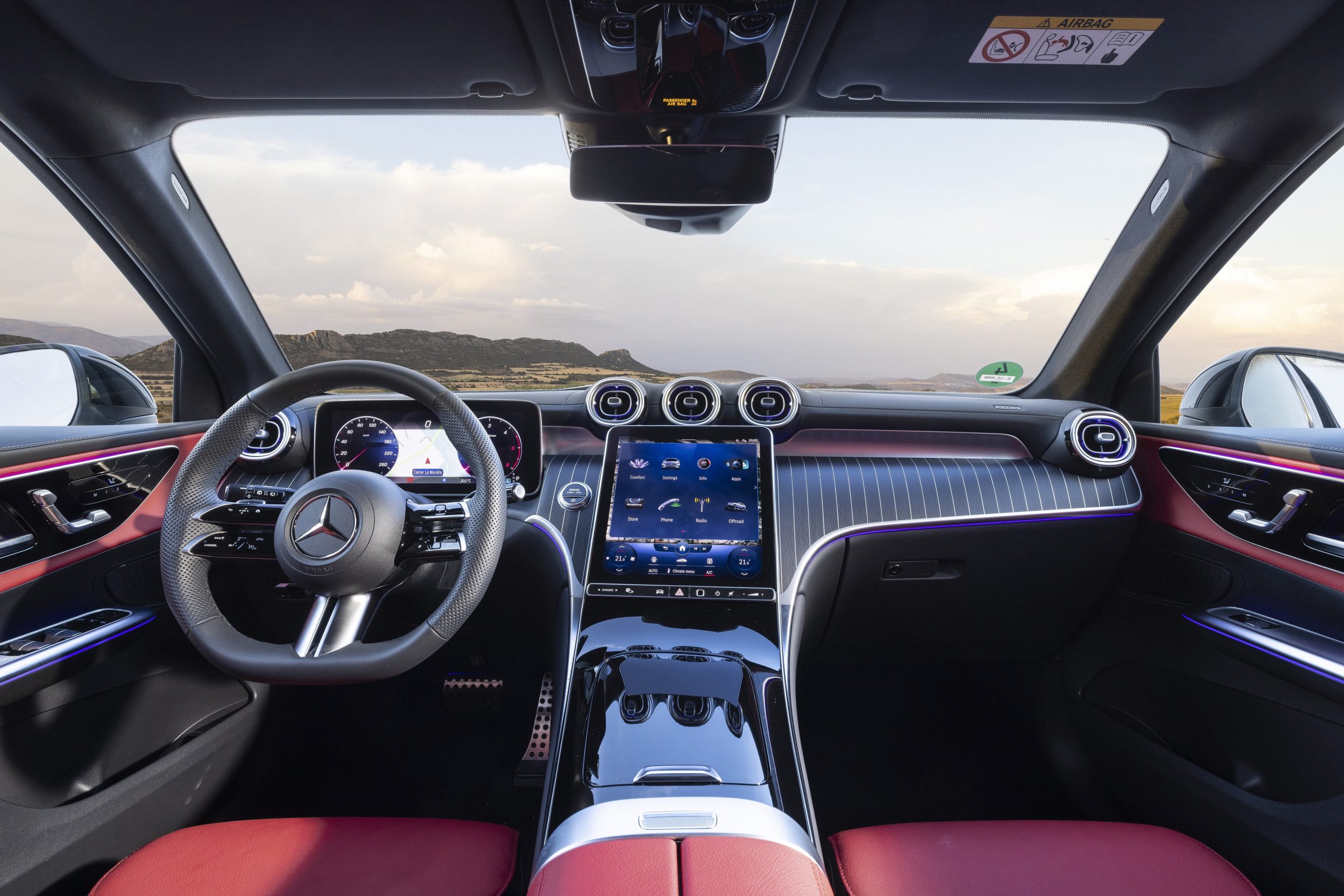Modern, sporty luxury, the new GLC embodies this in every detail. It is the most dynamic model in the successful SUV family from Mercedes-Benz. Even at first glance, this is underlined by its design with unique proportions, dramatic surfaces, precisely moulded edges and a clearly laid-out, high-quality interior. It also impresses with its driving performance and efficiency.
The GLC is at home on any terrain: whether on or off the road in Oman or abroad, it impresses with its comfort and agility. The new rear-axle steering makes it even more manoeuvrable and safe. Off the road, it scores with numerous features such as the standard 4MATIC, purely electric off-road driving in the plug-in models, the off-road screen and the “transparent bonnet”.
Success story: Mid-Size SUV from Mercedes-Benz
Mercedes-Benz entered the mid-size SUV segment in 2008, with the GLK. Its exterior design was unmistakably derived from the G-Class, the forefather of all Mercedes-Benz SUVs. in 2015 the brand presented its successor under the name GLC. This also impressed with the excellent safety typical of the brand, state-of-the-art assistance systems, energy efficiency and high dynamics. Since the GLC’s introduction and its direct predecessor, the GLK, Mercedes-Benz has sold more than 2.6 million examples worldwide. The GLC presented now is the third generation, and seamlessly continues this success story.
Exterior design: Expressive highlights
One of the defining design highlights of the GLC is the redesigned front end, with headlamps that connect directly to the radiator grille to emphasise the vehicle’s width. DIGITAL LIGHT headlamps with additional daytime driving light ellipses and new blue trim, plus active floor lighting, are available as optional extras. The typical Mercedes SUV radiator grille with redesigned cut-out has a chrome surround. This frames a sporty louvre in matt grey with chrome trim and the grille with vertical louvres in high-gloss black. From the AMG Line upwards, a radiator grille with Mercedes-Benz pattern is available: a three-dimensional star pattern with high-gloss chrome surfaces. The new simulated underguard in chrome at the front emphasises the vehicle’s width and accentuates the off-road look.
The body design is characterised by a full, spanned surface design enriched with precisely shaped edges in the sides. These emphasise the proportions as well as the muscular wheel arches and create a balance between elegance and off-road performance. Wheel arch liners in the vehicle colour are available from the AMG Line upwards for the first time. These accentuate the sportiness of the AMG Line.
Other features of the sporty, confident appearance are the wide track and flush wheels in 18- to 20-inch size. Several of the wheels available ex-factory not only feature a modern design with a high-sheen finish and bicolour surfaces but are also aerodynamically optimised.
Interior design: Modern, sporty luxury
The dashboard is clearly structured: the upper section has a wing-like profile with new, flattened round nozzles reminiscent of the engine nacelles of an aircraft. The lower section has a generous trim area that flows harmoniously into the curved centre console. Its orientation towards the driver contributes to sportiness: the dashboard is slightly angled towards the driver by six degrees.
There is a free-standing, high-resolution LCD screen in front of the driver. It appears to float in front of the wing profile and trim area. This sets the driver’s display apart from traditional cockpits with classic dial instruments. It has a size of 12.3 inches (31.2 centimetres).
The central display also makes the paradigm shift towards digitisation clear: the vehicle functions can be controlled using the high-quality touchscreen. Its portrait orientation is particularly advantageous for navigation. Like the dashboard, the screen surface is slightly angled towards the driver. The central display has a screen diagonal of 11.9 inches (30.2 centimetres). Ergonomically located below the central display is a fingerprint scanner. A colour head-up display can be ordered as optional equipment.
The modern, highly reduced design of the door panels frames both ends of the dashboard. The door centre panel with integrated armrest evolves from a vertical surface into a horizontal orientation. Reflecting the design of the centre console, the front section takes the form of a metallic high-tech element. It can be used as a grab or closing handle and houses the power window controls. Another highlight is the floating control cluster, into which the door opener and seat adjustment controls are integrated.
The new GLC is available with a leather-lined dashboard with nappa-look beltlines (optional, standard for the AMG Line). Some trim elements have innovative surfaces.


Previous
Next
Intuitively operated and learn-capable: Latest generation of MBUX
After the S-Class and C-Class, the new GLC also receives the second generation of the MBUX (Mercedes-Benz User Experience) infotainment system. The vehicle interior becomes even more digital and intelligent as both the hardware and software have made great strides: on the LCD screens, brilliant images make it easy to control vehicle and comfort functions.
The driver and central display offer a holistic, aesthetic experience. The information is presented in a clearly structured way. The appearance can be individualised with a total of three display styles (classic, sporty, discreet) and three modes (navigation, assistance, service). In addition, the GLC offers the off-road mode.
-
In “classic” style, the driver is welcomed with a familiar display environment. The proven display of two tubes and alternating content in between provides all driving-related information.
-
In “sporty” style, the colour red dominates and the central rev counter is dynamically presented.
-
In “discreet” style, the content is reduced to what is essential. In addition, the two screens can be shown in seven colour schemes with the ambience lighting. This creates an impressive colour experience in the interior.
-
The “assistance” mode displays the traffic situation in real time and supplements it with important display information.
-
The new “off-road” mode makes it possible to visually experience specific content such as gradient, inclination, compass and steering angle and, in conjunction with the optional 360-degree camera, offers the “transparent bonnet” function.
Full-screen navigation offers the driver the best possible guidance while driving. Augmented Video is available as optional equipment. A camera registers the surroundings in front of the vehicle. The central display shows the moving images and also superimposes virtual objects, information and markers. These include, for instance, traffic signs, directional arrows, lane-change recommendations, and house numbers. This can make navigation much easier, especially in urbanised areas across Oman.
All-wheel drive: Mercedes-Benz 4MATIC
All models of the new GLC come with the latest 4MATIC all-wheel drive system. The new front-axle drive allows higher torque levels to be transferred, with an ideal axle load distribution for driving dynamics. This also has a considerable weight advantage compared to the axle drive of the preceding series. The longitudinal transfer case, which is also new, further reduces friction losses. It also has a closed oil circuit and does not require any additional cooling measures.
Suspension: Agility and safety
Key components of the GLC’s dynamically designed suspension system are a new four-link suspension at the front and a multi-link independent rear suspension mounted to a subframe. The standard suspension already provides a high level of suspension, ride and noise comfort, agile handling and driving enjoyment. It is equipped with an amplitude-dependent damping system.
The new GLC is particularly agile and stable with the optional rear-axle steering combined with a more direct steering ratio at the front axle. The steering angle at the rear axle is up to 4.5 degrees. This reduces the turning circle by 80 centimetres to 11.0 metres. The driver also needs fewer turns of the steering wheel from lock to lock.
At speeds of less than 60 km/h, the rear wheels steer in the opposite direction to the front wheels – when parking, by up to 4.5 degrees counter to the front axle angle. Depending on the situation, this virtually shortens the wheelbase, and the vehicle is more light-footed and agile as a result. When the speed reaches 60 km/h or more, the rear wheels steer in the same direction as the front wheels by up to 4.5 degrees. This virtual increase in wheelbase has noticeable advantages: in the form of improved handling stability and safety at high speeds, during fast lane-changes or sudden evasive manoeuvres. In addition, during dynamic manoeuvres such as driving on roads cut through the mountains in Oman, significantly less steering movement is required – and the vehicle responds more directly to steering commands.
Latest assistance systems: Supporting the driver
The latest generation of the Driving Assistance package Plus contains additional and improved functions. These reduce driver workload in day-to-day situations for more comfortable and safe driving. When danger threatens, the assistance systems can respond to impending collisions as the situation demands. Several advanced features can make driving even safer. Active Distance Assist DISTRONIC, for example, can now react to stationary vehicles on the road at speeds of up to 100 km/h (previously 60 km/h). One of the new features of Active Steering Assist is lane detection with an additional 360-degree camera, which particularly offers advantages at low speeds, for example when forming an emergency lane. As well as signposted speed limits, Traffic Sign Assist now also recognises conditional signs such as “in wet conditions”. The stop sign and red traffic light warning functions are new.
Over hill and dale: Off-road with the GLC
As before, the new GLC has also been explicitly designed for off-road driving, including thrilling adventures in Oman, and is prepared for this use with several new features and systems. Standard equipment includes an off-road driving mode and DSR (Downhill Speed Regulation).
In off-road mode, the GLC with 360-degree camera offers a “transparent bonnet”: The central display shows a virtual view under the front of the vehicle, including the front wheels and their steering position. This is extremely helpful: it enables the driver to recognise obstacles such as large stones or deep potholes in the vehicle’s path at an early stage.
The new off-road screen uses both displays for clearly arranged information, controls and functions. Among other things, the driver’s display shows, inclination, gradient, topographical altitude, geo-coordinates and a compass, as well as road speed and engine speed when operating with an internal combustion engine. The central display additionally shows e.g. the current position of the SUV in the terrain as well as the steering angle of the front wheels, and if rear-wheel steering is available, the steering direction of the rear wheels. All the driving functions relevant for off-road operation can be controlled very easily on one screen.
The model range:
|
|
|
GLC 200 4MATIC |
GLC 300 4MATIC |
Displacement |
cc |
1,999 |
1,999 |
Output |
kW/hp |
150/204 |
190/258 |
at |
rpm |
5,800-6,100 |
5,800 |
Add. output (boost effect) |
kW/hp |
17/23 |
17/23 |
Peak torque |
Nm |
320 |
400 |
at |
rpm |
1,800-4,000 |
2,000-3,200 |
Add. torque (boost effect) |
Nm |
200 |
200 |
Comb. fuel consumption (WLTP)1 |
l/100 km |
8.2-7.3 |
8.2-7.3 |
Combined CO2 emissions (WLTP)1 |
g/km |
186-167 |
186-167 |
Acceleration 0-100 km/h |
s |
7.8 |
6.2 |
Top speed |
km/h |
221 |
240 |

